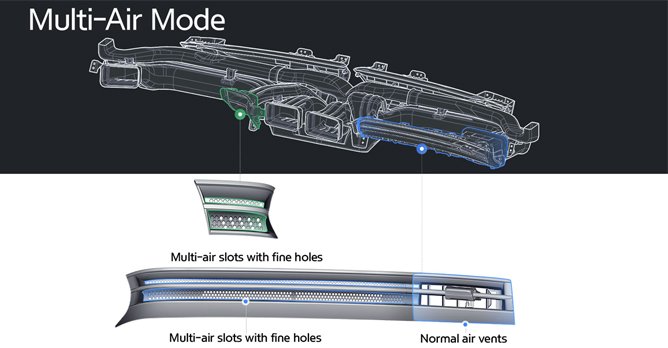Hyundai Motor Group develops air-conditioning technologies
31 Jul 2020|219 views
Hyundai Motor Group announces new technologies to improve the quality of air in vehicles and create a more pleasant indoor environment for customers.
Recognising the growing concern about air quality, the Group unveiled three new air-conditioning technologies - 'After-Blow', 'Multi-Air Mode' and 'Fine Dust Indicator', which will be introduced initially on select models in Korea and expand to upcoming Hyundai, Kia and Genesis vehicles worldwide in the future.
'After-Blow' dries the condensate on the evaporator and suppresses mould growth in the air-conditioning system, which can cause an odour during hot weather. Once the engine is turned off, 'After-Blow' activates for 10 minutes to dry the evaporator and any condensate leftover. The air-conditioning system automatically allows influx of outside air during this time to prevent humidity from building up.
The technology uses an intelligent battery sensor to monitor the battery and stops functioning when the battery is low. It also de-activates when the air conditioning system is not in use for a certain period of time, or when the outside temperature is low.
'Multi-Air Mode' uses multiple vents for air conditioning and heating to create a more pleasant indoor environment with gentle wind. When this mode is activated, the air is dispersed to the newly added multi-air slots in the driver and passenger seats in addition to the normal air vents. The overall wind volume remains the same, but the dispersion of wind reduces direct air contact and softens the air. This mode can be switched on and off based on the preference of the driver.
'Fine Dust Indicator' measures the air inside the vehicle in real time and delivers digitised information, allowing the driver to better manage the air quality.
The indicator displays the concentration and pollution level of ultra-fine PM 2.5 particles inside the vehicle using integer numbers and colours for better visibility to the user: blue for 0 to 15μg/m3, green for 16 to 35μg/m3, orange for 36 to 75μg/m3, and red for 76μg/m3 or higher.
If the level of ultrafine particles exceeds 36μg/m3 while the function is active, the air-cleaning mode will run to purify the air in the vehicle. The air-cleaning system automatically sets the air volume between three and eight and switches to air-recirculation mode and activates the air conditioning system to reduce indoor humidity. If the air does not improve in air-cleaning mode, it can also serve as a reminder to the driver to replace air-conditioner filters or to clean contaminated seats and mats.
Hyundai Motor Group announces new technologies to improve the quality of air in vehicles and create a more pleasant indoor environment for customers.
Recognising the growing concern about air quality, the Group unveiled three new air-conditioning technologies - 'After-Blow', 'Multi-Air Mode' and 'Fine Dust Indicator', which will be introduced initially on select models in Korea and expand to upcoming Hyundai, Kia and Genesis vehicles worldwide in the future.
'After-Blow' dries the condensate on the evaporator and suppresses mould growth in the air-conditioning system, which can cause an odour during hot weather. Once the engine is turned off, 'After-Blow' activates for 10 minutes to dry the evaporator and any condensate leftover. The air-conditioning system automatically allows influx of outside air during this time to prevent humidity from building up.
The technology uses an intelligent battery sensor to monitor the battery and stops functioning when the battery is low. It also de-activates when the air conditioning system is not in use for a certain period of time, or when the outside temperature is low.
'Multi-Air Mode' uses multiple vents for air conditioning and heating to create a more pleasant indoor environment with gentle wind. When this mode is activated, the air is dispersed to the newly added multi-air slots in the driver and passenger seats in addition to the normal air vents. The overall wind volume remains the same, but the dispersion of wind reduces direct air contact and softens the air. This mode can be switched on and off based on the preference of the driver.
'Fine Dust Indicator' measures the air inside the vehicle in real time and delivers digitised information, allowing the driver to better manage the air quality.
The indicator displays the concentration and pollution level of ultra-fine PM 2.5 particles inside the vehicle using integer numbers and colours for better visibility to the user: blue for 0 to 15μg/m3, green for 16 to 35μg/m3, orange for 36 to 75μg/m3, and red for 76μg/m3 or higher.
If the level of ultrafine particles exceeds 36μg/m3 while the function is active, the air-cleaning mode will run to purify the air in the vehicle. The air-cleaning system automatically sets the air volume between three and eight and switches to air-recirculation mode and activates the air conditioning system to reduce indoor humidity. If the air does not improve in air-cleaning mode, it can also serve as a reminder to the driver to replace air-conditioner filters or to clean contaminated seats and mats.
Latest COE Prices
June 2025 | 1st BIDDING
NEXT TENDER: 18 Jun 2025
CAT A$96,999
CAT B$113,000
CAT C$62,000
CAT E$113,900
View Full Results Thank You For Your Subscription.


























